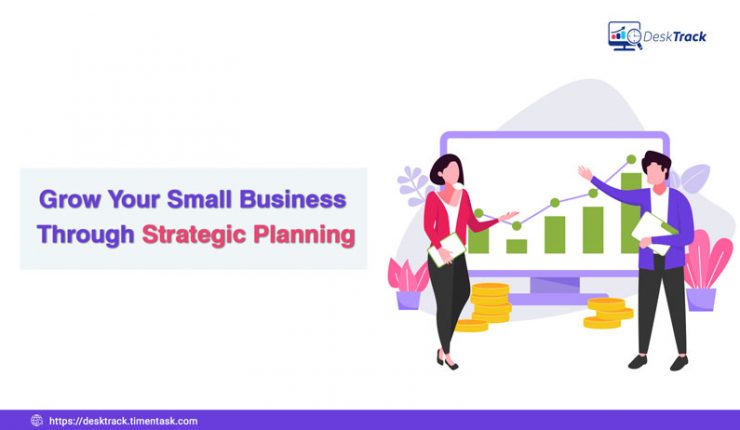
In the dynamic landscape of today’s business world, the pursuit of growth is essential for organizations aiming to thrive and stay ahead of the competition. Business growth is not just about increasing revenue. It encompasses expanding market share, reaching new customers, and solidifying your brand’s position.
Let’s delve into the exciting realm of business growth and explore the key strategies and creative approaches to grow your small business that can propel your organization to new heights of success.
Setting Goals for Business Growth
To embark on a successful growth journey, it is crucial to set clear goals and objectives. Start by defining your organization’s vision and mission, encapsulating the essence of what you aim to achieve. Your vision serves as a guiding light, while your mission outlines the purpose and values that drive your business.
Next, establish measurable objectives that align with your vision and mission. These objectives act as milestones, allowing you to track progress and evaluate your growth strategies effectively.
Defining Your Vision and Mission
Your vision and mission serve as the guiding principles for your business. Your vision is a long-term, inspiring statement that defines where you want your business to be in the future. It encapsulates your aspirations and paints a vivid picture of what success looks like for your organization. Your mission, on the other hand, outlines the purpose of your business and the value it delivers to its customers or stakeholders. It provides direction and clarity about why your business exists.
Establishing Measurable Objectives
Once you have defined your vision and mission, it’s time to set measurable objectives that will help you achieve them. Measurable objectives are specific, quantifiable targets that provide clarity and focus for your efforts.
They serve as milestones along your journey toward realizing your vision. When setting objectives, consider the SMART framework: Specific, Measurable, Achievable, Relevant Time-bound
Conducting Market Research to Grow Your Small Business
Market research is the compass that directs your expansion initiatives. It entails knowing your target market, determining client wants and preferences, and staying up to date on industry developments.
You can learn about customer behavior, market demand, and prospects for innovation by conducting extensive market research. Analyzing competition and industry trends gives vital knowledge that allows you to strategically position your business and separate yourself from competitors.
How do you Carry out Effective Market Research?
- Define your Target Market: Begin by determining the precise group of consumers or businesses you wish to target. Recognize their demographics, behaviors, and requirements. This will allow you to modify your products or services to match their needs.
- Utilize a Mix of Qualitative and Quantitative Research: Qualitative research, such as focus groups or interviews, allows you to delve deeper into consumer motivations and preferences. Quantitative research, through surveys or data analysis, provides statistical insights and helps quantify market trends and preferences.
- Gather Data from Multiple Sources: Combine primary research (directly collected from your target market) and secondary research (existing data from industry reports, government sources, or market research firms). This comprehensive approach ensures a well-rounded understanding of the market landscape.
- Use Surveys and Questionnaires Effectively: When creating surveys, be clear, concise, and ensure that questions are unbiased. Consider using open-ended questions to gather detailed feedback and closed-ended questions for quantitative data analysis. Offer incentives to increase response rates.
- Monitor Industry Trends: Stay up-to-date with industry news, reports, and publications. Understand emerging technologies, consumer behaviors, and market dynamics. This knowledge will enable you to identify opportunities for innovation or potential threats to your business.
Building a Solid Marketing Strategy
Building a solid and strong marketing strategy is a remarkably important component to Grow Your Small Business. By creating a comprehensive marketing plan, utilizing digital marketing channels, and implementing effective campaigns, you can increase brand visibility, attract customers, and drive business development. Remember to continuously analyze the market, adapt to changing trends, and listen to your customers’ feedback.
A well-executed marketing strategy can be a game-changer for your business, igniting the spark of growth and propelling your brand towards success in today’s dynamic marketplace.
Creating a Marketing Plan
A clear marketing plan serves as a road map for your marketing operations. Begin by conducting market research to better understand your target audience’s demands and preferences. Determine your unique selling proposition (USP), which distinguishes you from the competition.
Set specific marketing goals and define the methods and tactics you will employ to attain them. Your marketing plan needs to have a budget, a timetable, and key performance indicators (KPIs) so that you can monitor the success of your marketing initiatives.
Utilizing Digital Marketing Channels
Using digital marketing channels to reach and engage your target audience is extremely vital and necessary in this day and age. Create a professional website that promotes your products or services to establish a strong online presence. Improve your website’s exposure in search results by optimizing it for search engines (SEO).
Get social media onboard, try out modern ways such as email marketing, or paid advertising ( works the best) focus on forming connections, and create a supportive online community to score points.
Putting into Practise Successful Marketing Campaigns
The end result of increasing consumer awareness of your company and its goods is an improvement in your financial standing. Research is crucial for a successful campaign in light of this.
Research and concept testing is a must as they will result in the creation of compelling campaign content. The process of marketing execution includes turning your marketing strategy into reality.
Crafting Customer Experience: Creating Moments that Matter
In today’s competitive business landscape, delivering an exceptional customer experience is no longer optional; it’s a necessity. By understanding and meeting customer needs and preferences, providing exceptional service, and implementing feedback-driven improvements, Scaling up your business can cultivate long-lasting relationships and drive growth. Enhance the customer experience, from understanding customer needs to improving operational efficiency, ultimately building a loyal customer base and thriving in the market.
1. Understanding Customer Needs and Preferences
To provide a super exceptional customer experience, you must first understand your clients well. Conduct market research, collect feedback, and analyze customer data to learn about their needs, pain areas, and preferences. You may exceed their expectations and develop long-lasting relationships by aligning your products, services, and interactions with their expectations.
2. Providing Exceptional Customer Service
Exceptional customer service is the cornerstone of a memorable customer experience. Train and empower your employees to deliver personalized, attentive, and empathetic service. Create a culture that prioritizes customer satisfaction and goes above and beyond to address customer concerns promptly and effectively. By providing a consistently positive experience, you can turn customers into brand advocates.
3. Implementing Customer Feedback and Improvements
Actively seek and implement customer feedback to drive continuous improvement. Utilize surveys, customer reviews, and social media listening tools to gather insights. Analyze this feedback to identify areas for enhancement and develop action plans to address customer pain points. By incorporating customer suggestions and making iterative improvements, you demonstrate your commitment to meeting their needs.
Leveraging the Power of Online Presence
Everything is online and so should your business. A solid online presence is vital for businesses to prosper and interact with their target audience in the digital era. Businesses may leverage the power of the internet to expand their reach, generate brand authority, and drive growth by developing a professional website, optimizing for search engines (SEO), and utilizing social media platforms.
Creating a Professional Website
A quality website serves as your company’s internet storefront. It is the initial impression your brand makes on customers. Make an investment in developing a visually appealing and user-friendly website that reflects your company’s identity.
Make sure your website is responsive and accessible on a variety of devices and platforms and most importantly it should be mobile friendly. Include necessary information like your products or services, contact information, and a clear call to action. Provide visitors with intriguing information that educates and informs them about your offerings.
Optimizing for Search Engines (SEO)
Search engine optimization (SEO) (you must have heard of it) is essential for increasing the visibility and ranking of your website in search engine results. Conduct keyword research to find out what keywords and phrases your target audience is looking for.
Add relevant keywords naturally into the content, meta tags, headings, and URLs of your website. Improve the loading speed, mobile friendliness, and user experience of your website. Create high-quality backlinks from reliable websites to increase the reputation of your website in the eyes of search engines.
Utilizing Social Media Platforms
Social media platforms are the most effective approach to engaging with your audience and increasing brand visibility. Social media helps businesses develop and remain relevant. The most important findings. Bottom-line growth is fueled by social media. Social media allows every business to reach out to new people, potentially a large number of them at once. Building a social media brand is similar to having a sales crew working for you.
With more than half of the world’s population using social media, platforms such as Facebook, Instagram, or Twitter are an obvious way to reach new and highly targeted potential clients. One of the most important advantages of social media for business is the opportunity to make genuine human connections (also known as Meaningful Relationship Moments).
Introduce your followers to the people who make up your firm and demonstrate how current consumers use and profit from your products. Whatever industry you are in, social media allows you to create your brand as a thought leader—the go-to source for information on topics connected to your area.
Expanding Your Customer Base
Customers are the heart and soul of any business, thus you must continue to create leads and retain existing customers. However, doing so regularly causes firms distress, with more than one-third indicating that generating new business is their top priority.
Business owners are continuously looking for innovative ways to increase their customer base. They concentrate not only on recruiting new consumers, but also on retaining existing ones because selling to an existing customer has a likelihood of 60-70%, but selling to a new prospect has a possibility of 5-20%.
Implementing Targeted Lead Generation Strategies
A solid lead generation plan ensures a continuous and predictable flow of fresh leads into the sales pipeline, allowing you to streamline your sales and marketing operations and maximize ROI. A lead generation strategy is a method of attracting, acquiring, and nurturing high-quality leads to turn them into paying clients.
- Content Marketing: To draw in your target audience, create valuable and relevant material such as blog articles, videos, or tutorials. Provide gated content, such as e-books or whitepapers, in exchange for users providing their contact information.
- Email Marketing: Build an email list and nurture leads through personalized email campaigns. Provide valuable information, exclusive offers, or discounts to encourage conversions.
- Paid Advertising: Utilize paid advertising platforms, such as Google Ads or social media advertising, to target specific demographics and drive traffic to your website or landing pages.
2. Effective Networking and Partnerships
Networking and forming strategic partnerships can significantly expand your customer base by tapping into new markets and reaching a wider audience. Consider the following strategies:
- Attend Industry Events: Participate in trade shows, conferences, or networking events relevant to your industry. Engage with industry professionals, and potential customers, and form connections that can lead to business opportunities.
- Collaborate with Complementary Businesses: Identify businesses that share a similar target audience but offer non-competing products or services. Explore partnership opportunities to cross-promote each other’s offerings and reach new customers.
- Influencer Marketing: Collaborate with influencers or industry experts who have a strong online presence and a large following. Their endorsement or recommendation can introduce your brand to a new audience and generate interest in your products or services.
Scaling Up Your Business
As a business owner, the dream of scaling up and achieving sustainable growth is always within reach. It requires careful planning, strategic decision-making, and a willingness to adapt to change. For scaling up your business, from assessing readiness and securing financing to nurturing employee growth and overcoming challenges. By embracing these principles, you can embark on a path towards long-term success and establish your business as a force to be reckoned with.
Assessing Readiness for Growth
Before scaling up, it is crucial to assess your business’s readiness for growth. Evaluate your infrastructure, systems, and processes to ensure they can handle increased demand. Assess your financial health, market position, and customer base to determine if you have a solid foundation to support expansion. Understanding your current strengths and weaknesses will help you identify areas that require attention and improvement.
Securing Financing and Funding Options
Scaling up often requires additional financial resources. Explore different funding options, such as loans, investors, or crowdfunding platforms, to secure the necessary capital. Prepare a compelling business plan and financial projections to showcase the potential return on investment. Consider partnering with organizations that support business growth or seeking out grants and incentives available in your industry.
Expanding into New Markets or Locations
Expanding into new markets or locations can unlock untapped potential for growth. Conduct thorough market research to identify target markets with high demand and growth potential. Develop a market entry strategy that aligns with your business goals. Consider factors such as cultural nuances, regulatory requirements, and competition. Tailor your offerings to cater to the specific needs and preferences of the new market.
Monitoring and Measuring Success
Global success has both unique and universal norms. The most typical business metrics used in small enterprises and startups include changes in cash flow, client counts, and Business Cost Control initiatives.
Monitoring and measuring essential performance is crucial. Choose metrics that are pertinent to your business goals and keep tabs on them frequently. Examine financial metrics such as cash flow, profitability, and revenue growth.
1. Tracking Key Performance Indicators (KPIs)
Monitoring the evolution of key performance indicators over a predetermined time frame is known as KPI tracking. Changes in the KPIs might show which company practices are effective and which may need to be improved. They can also assist you in keeping track of developments while your group, division, employees, or business strives to achieve a certain objective.
- Monitor your sales revenue to gauge the financial health and growth of your business. Analyze trends, identify areas of improvement, and set targets for revenue growth.
- Calculate the cost associated with acquiring a new customer. Tracking CAC helps you assess the efficiency of your marketing and sales efforts.
- Measure the percentage of customers who continue to do business with you over a specific period.
- Monitoring employees and their efficacy with the help of software such as DeskTask.
- Monitor the number of visitors to your website and analyze the sources and channels that drive traffic. This helps you understand the effectiveness of your marketing campaigns and identify areas for improvement.
2. Analyzing Financial Metrics
Financial metrics provide valuable insights into the financial performance and stability of your business. Regularly analyze financial statements and metrics such as:
- Gross Profit Margin: Calculate the percentage of revenue that remains after deducting the cost of goods sold. Monitoring your gross profit margin helps you evaluate pricing strategies and cost management.
- Cash Flow: Track the inflow and outflow of cash to ensure the availability of funds for day-to-day operations, investment, and growth. A positive cash flow indicates financial stability.
- Return on Investment (ROI): Evaluate the return on investment for specific initiatives or marketing campaigns. This helps you determine the profitability and effectiveness of your investments.
Employee Empowerment and Management
Driving growth, promoting creativity, and overcoming obstacles all depend on properly managing and empowering personnel. Businesses can foster an environment where people feel empowered to realize their full potential by identifying common growth roadblocks, putting strategies in place for managing and overcoming hurdles, and embracing innovation and flexibility with the use of tools like DeskTrack.
1. Recognising Typical Growth Obstacles
Prior to discussing management and employee empowerment, it’s critical to pinpoint typical growth challenges that companies may have. Typical challenges include:
- Employee Resistance to Change: Employee resistance to change may be brought on by apprehension about the future or an unwillingness to leave their comfort zones. This could stifle growth and innovation.
- Lack of Communication and Collaboration: Poor communication and limited collaboration can impede Employee Productivity, hinder problem-solving, and restrict the exchange of ideas and knowledge.
- Skill Gaps and Development: Insufficient skills or outdated knowledge may limit employee performance and hinder growth. Addressing skill gaps through training and development programs is vital.
2. Embracing Innovation and Flexibility with DeskTrack
DeskTrack, a Time Tracking Software, can be crucial in empowering staff members and encouraging creativity and adaptability. Here are some ways DeskTrack might support employee empowerment:
- Making Decisions Based on Data: DeskTrack offers useful insights on Employee productivity, time usage, and work patterns for data-driven decision-making. By using this information, judgments may be made that are well-informed, flaws can be found, and workflows can be improved.
- Flexible Work Arrangements: DeskTrack makes it possible for companies to properly track and manage remote work. Regardless of where they are located, it provides responsibility and helps track employee productivity.
- Time management and achieving work-life balance: DeskTrack’s time tracking, time-consuming task identification, and schedule optimization feature help employees manage their time and maintain a healthy work-life balance. This improves the ability to combine work and life and fosters general well-being.Remember to foster open communication, be in touch with employee development, and leverage technology to support flexibility and productivity. With a focus on employee empowerment and management, businesses can thrive in dynamic environments and achieve sustainable growth.
Conclusion
Scaling up your business requires careful planning, strategic decision-making, and a commitment to continuous improvement. By assessing readiness, securing financing, expanding into new markets, nurturing employee growth, monitoring success, and overcoming challenges, you can embark on a path towards sustainable small business growth.
Remember, scaling up is a journey that requires dedication and perseverance. Embrace opportunities for innovation, stay agile, and never lose sight of your long-term vision. With the right mindset and strategic execution. Grow Your Small Business and reach new heights of success.








